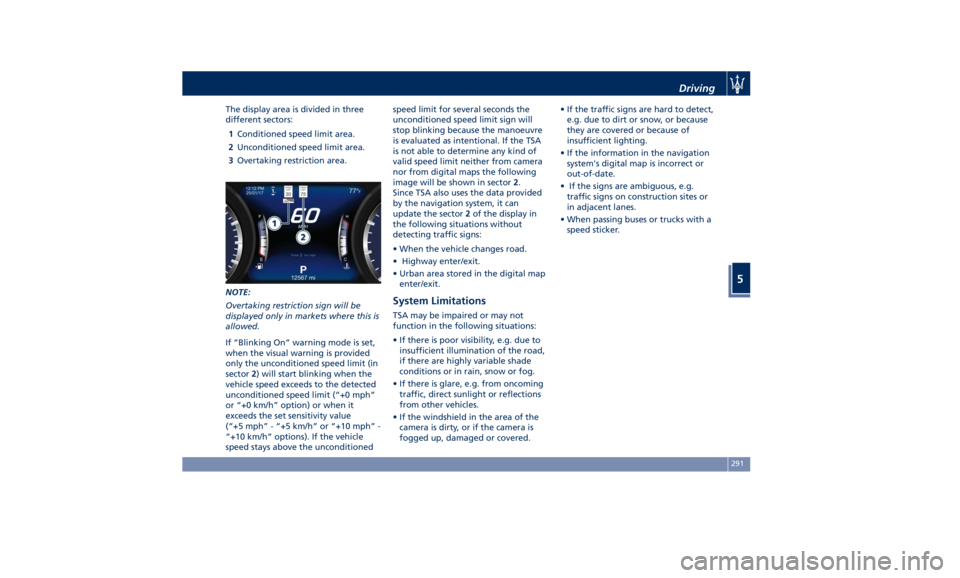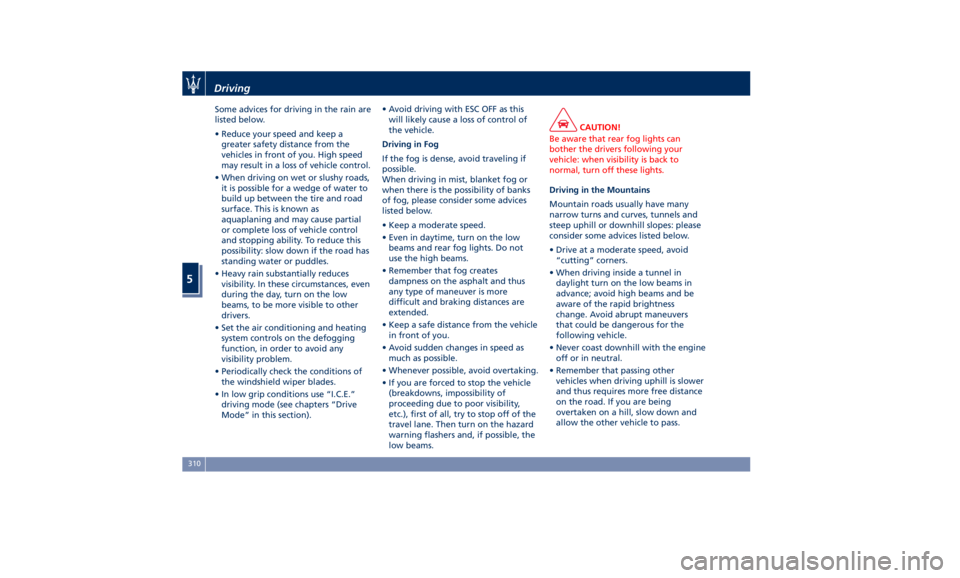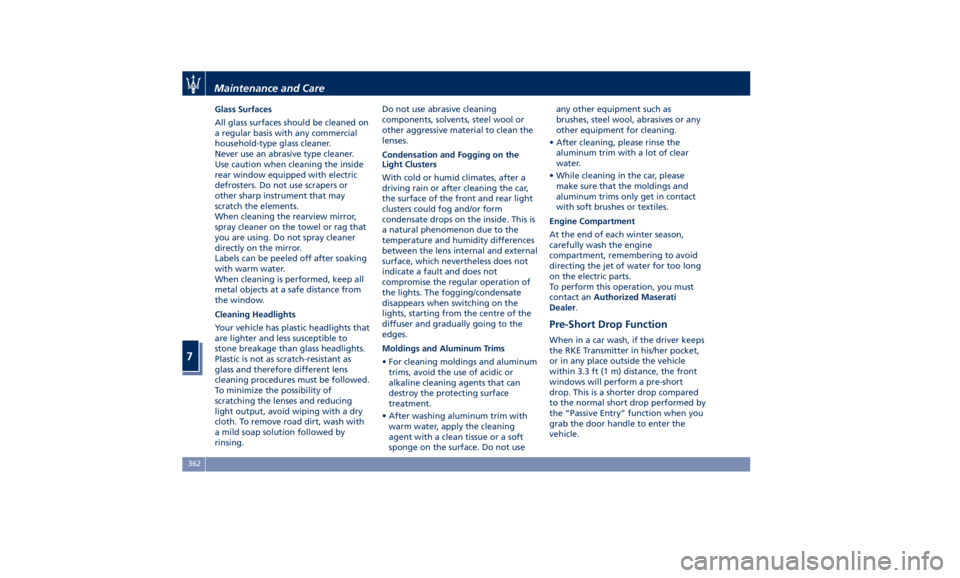2019 MASERATI QUATTROPORTE fog light
[x] Cancel search: fog lightPage 293 of 396

• Press the HAS enable button on
the steering wheel.
• Begin steering manually.
• Press brake pedal.
• Turn off ACC.
• Unbuckle the driver’s seat belt.
• Press ACC Gap button for two
seconds to enable CC system.
• Shift out of the (D) Drive gear.
• Enter an Autonomous Emergency
Braking (AEB) event (See chapter
"Forward Collision Warning - FCW"
in this section).
• Turn signal activated.
System Cancellation The HAS system will cancel (without
driver intervention) if either of the
following actions occur:
• Curve that is too tight.
• When leaving the grip of the hands
on the steering wheel.
• Vehicle exits the highway or limited
access freeway.
• Lane line markers aren’t detected by
the forward facing camera.
• Any ADAS system faults.
• ACC cancellation.
• Vehicle speed exceeds the maximum
limit. • Lateral accelerations exceeds the
limits.
NOTE:
• When HAS cancels, the
symbol
will turn red then grey.
• The presence of the hands on the
steering wheel is detected by a logic
combination of a capacitive sensor
installed in the steering wheel and
the measured applied torque at the
steering column. This leads to a
more robust hands detection.
System Limitations HAS is unable to guide the vehicle
when the following conditions occur.
• Lane markings are not clear or
visibility is poor (i.e. heavy rain,
snow, fog, etc.).
• Obstructed, covered or damaged
forward-facing camera or sensor.
• When driving on hills or sharp
curves.
• When approaching toll booths.
• When the highway entrance or exit
is wider than 20 ft (6 meters).
• Bright light (ex. direct sunlight or
glare) facing the forward camera. WARNING!
Many unforeseen conditions can occur
that can affect the performance of
Highway Assist (HAS). Always keep
this in mind and drive attentively. It is
the drivers responsibility to keep
control of the vehicle at all times.
Radar Device - Regulatory
Information The “Regulatory Information” for all
the radio frequency and radar devices
can be consulted by accessing the
“Services” section on the website
www.maserati.com.Driving
5
289
Page 295 of 396

The display area is divided in three
different sectors:
1 Conditioned speed limit area.
2 Unconditioned speed limit area.
3 Overtaking restriction area.
NOTE:
Overtaking restriction sign will be
displayed only in markets where this is
allowed.
If “Blinking On” warning mode is set,
when the visual warning is provided
only the unconditioned speed limit (in
sector 2 ) will start blinking when the
vehicle speed exceeds to the detected
unconditioned speed limit (“+0 mph”
or “+0 km/h” option) or when it
exceeds the set sensitivity value
(“+5 mph” - “+5 km/h” or “+10 mph” -
“+10 km/h” options). If the vehicle
speed stays above the unconditioned speed limit for several seconds the
unconditioned speed limit sign will
stop blinking because the manoeuvre
is evaluated as intentional. If the TSA
is not able to determine any kind of
valid speed limit neither from camera
nor from digital maps the following
image will be shown in sector 2 .
Since TSA also uses the data provided
by the navigation system, it can
update the sector 2 of the display in
the following situations without
detecting traffic signs:
• When the vehicle changes road.
• Highway enter/exit.
• Urban area stored in the digital map
enter/exit.
System Limitations TSA may be impaired or may not
function in the following situations:
• If there is poor visibility, e.g. due to
insufficient illumination of the road,
if there are highly variable shade
conditions or in rain, snow or fog.
• If there is glare, e.g. from oncoming
traffic, direct sunlight or reflections
from other vehicles.
• If the windshield in the area of the
camera is dirty, or if the camera is
fogged up, damaged or covered. • If the traffic signs are hard to detect,
e.g. due to dirt or snow, or because
they are covered or because of
insufficient lighting.
• If the information in the navigation
system's digital map is incorrect or
out-of-date.
• If the signs are ambiguous, e.g.
traffic signs on construction sites or
in adjacent lanes.
• When passing buses or trucks with a
speed sticker.Driving
5
291
Page 314 of 396

Some advices for driving in the rain are
listed below.
• Reduce your speed and keep a
greater safety distance from the
vehicles in front of you. High speed
may result in a loss of vehicle control.
• When driving on wet or slushy roads,
it is possible for a wedge of water to
build up between the tire and road
surface. This is known as
aquaplaning and may cause partial
or complete loss of vehicle control
and stopping ability. To reduce this
possibility: slow down if the road has
standing water or puddles.
• Heavy rain substantially reduces
visibility. In these circumstances, even
during the day, turn on the low
beams, to be more visible to other
drivers.
• Set the air conditioning and heating
system controls on the defogging
function, in order to avoid any
visibility problem.
• Periodically check the conditions of
the windshield wiper blades.
• In low grip conditions use “I.C.E.”
driving mode (see chapters “Drive
Mode” in this section). • Avoid driving with ESC OFF as this
will likely cause a loss of control of
the vehicle.
Driving in Fog
If the fog is dense, avoid traveling if
possible.
When driving in mist, blanket fog or
when there is the possibility of banks
of fog, please consider some advices
listed below.
• Keep a moderate speed.
• Even in daytime, turn on the low
beams and rear fog lights. Do not
use the high beams.
• Remember that fog creates
dampness on the asphalt and thus
any type of maneuver is more
difficult and braking distances are
extended.
• Keep a safe distance from the vehicle
in front of you.
• Avoid sudden changes in speed as
much as possible.
• Whenever possible, avoid overtaking.
• If you are forced to stop the vehicle
(breakdowns, impossibility of
proceeding due to poor visibility,
etc.), first of all, try to stop off of the
travel lane. Then turn on the hazard
warning flashers and, if possible, the
low beams. CAUTION!
Be aware that rear fog lights can
bother the drivers following your
vehicle: when visibility is back to
normal, turn off these lights.
Driving in the Mountains
Mountain
roads usually
have many
narrow turns and curves, tunnels and
steep uphill or downhill slopes: please
consider some advices listed below.
• Drive at a moderate speed, avoid
“cutting” corners.
• When driving inside a tunnel in
daylight turn on the low beams in
advance; avoid high beams and be
aware of the rapid brightness
change. Avoid abrupt maneuvers
that could be dangerous for the
following vehicle.
• Never coast downhill with the engine
off or in neutral.
• Remember that passing other
vehicles when driving uphill is slower
and thus requires more free distance
on the road. If you are being
overtaken on a hill, slow down and
allow the other vehicle to pass.Driving
5
310
Page 360 of 396

CAUTION!
It is not possible replace a single LED
of the headlight cluster: we
recommend that you contact an
Authorized Maserati Dealer for the
replacement of the entire headlight
cluster.
Tail-Light Clusters The lights are arranged as follows:
1 Position light guide LED.
2 Stop light LED.
3 Side-marker LED.
4 Turn signal LED.
5 Reverse LED.
6 Reflectors.
7 Rear fog LED. CAUTION!
It is not possible replace a single LED
of the tail-light cluster, we recommend
that you contact an Authorized
Maserati Dealer for the replacement
of the entire cluster.
Light Clusters Replacement All lights in the front and rear clusters
and those integrated in the exterior
mirrors are LED powered and cannot
be replaced individually.
Contact an Authorized Maserati
Dealer to locate the correct parts and
replace them.
License Plate Lights To replace the license plate light bulb
(C 5W): • use a screwdriver positioned at the
indicated point to lever out the light
fixing frame;
• replace the pressure-fitted bulb;
• refit the bulb holder inserting first
the electrical connector side and
then pressing on the other side to
hook up the clip.
Interior Lights Lamps inside the glove box
compartments of the dashboard andMaintenance and Care
7
356
Page 366 of 396

Glass Surfaces
All glass surfaces should be cleaned on
a regular basis with any commercial
household-type glass cleaner.
Never use an abrasive type cleaner.
Use caution when cleaning the inside
rear window equipped with electric
defrosters. Do not use scrapers or
other sharp instrument that may
scratch the elements.
When cleaning the rearview mirror,
spray cleaner on the towel or rag that
you are using. Do not spray cleaner
directly on the mirror.
Labels can be peeled off after soaking
with warm water.
When cleaning is performed, keep all
metal objects at a safe distance from
the window.
Cleaning Headlights
Your vehicle has plastic headlights that
are lighter and less susceptible to
stone breakage than glass headlights.
Plastic is not as scratch-resistant as
glass and therefore different lens
cleaning procedures must be followed.
To minimize the possibility of
scratching the lenses and reducing
light output, avoid wiping with a dry
cloth. To remove road dirt, wash with
a mild soap solution followed by
rinsing. Do not use abrasive cleaning
components, solvents, steel wool or
other aggressive material to clean the
lenses.
Condensation and Fogging on the
Light Clusters
With cold or humid climates, after a
driving rain or after cleaning the car,
the surface of the front and rear light
clusters could fog and/or form
condensate drops on the inside. This is
a natural phenomenon due to the
temperature and humidity differences
between the lens internal and external
surface, which nevertheless does not
indicate a fault and does not
compromise the regular operation of
the lights. The fogging/condensate
disappears when switching on the
lights, starting from the centre of the
diffuser and gradually going to the
edges.
Moldings and Aluminum Trims
• For cleaning moldings and aluminum
trims, avoid the use of acidic or
alkaline cleaning agents that can
destroy the protecting surface
treatment.
• After washing aluminum trim with
warm water, apply the cleaning
agent with a clean tissue or a soft
sponge on the surface. Do not use any other equipment such as
brushes, steel wool, abrasives or any
other equipment for cleaning.
• After cleaning, please rinse the
aluminum trim with a lot of clear
water.
• While cleaning in the car, please
make sure that the moldings and
aluminum trims only get in contact
with soft brushes or textiles.
Engine Compartment
At the end of each winter season,
carefully wash the engine
compartment, remembering to avoid
directing the jet of water for too long
on the electric parts.
To perform this operation, you must
contact an Authorized Maserati
Dealer .
Pre-Short Drop Function When in a car wash, if the driver keeps
the RKE Transmitter in his/her pocket,
or in any place outside the vehicle
within 3.3 ft (1 m) distance, the front
windows will perform a pre-short
drop. This is a shorter drop compared
to the normal short drop performed by
the “Passive Entry” function when you
grab the door handle to enter the
vehicle.Maintenance and Care
7
362
Page 389 of 396

Older Children and Child
Restraints .................75
Tips on getting the most out of your
child restraint ..............76
Climate Control ............. .203
Clock, analog .............. .192
Console
Central Console Components ....95
Front Dome Console
Components ...............96
Instrument Panel on the Rear
Central Console ........... .106
Rear Console
Components/Features ....... .107
Controls Screen ............. .185
Cruise Control
Cruise Control Adaptive (ACC) . .257
Electronic Cruise Control (CC) . . .254
Cupholders ................ .132
Front Passengers Cupholders . . .132
Rear Passengers Cupholders . . .133
Dashboard Compartment ...... .200
Dashboard Components .........94
Defroster ...................50
Doors
Child Protection Door Lock
System ...................41
Doors Locking ..............39
Doors Manual Lock ...........39
Front Doors Components ......96
Lock/Unlock Door Flashlight ....34
Power Doors Locking/Unlocking . .40 Rear Doors Components .......98
Soft Door Close System ........41
Unlock Driver Door/All Doors with
Remote Key 1st Press .........34
Unlock the Doors, Fuel Filler Door
and Trunk .................34
Unlock the Vehicle ...........33
DPF System
DPF Filter Replacement ...... .340
“Drive Away Inhibit” strategy . . . .247
Drive Mode, controls ......... .234
Setting the Drive Mode ...... .234
Driving Conditions ........... .309
Before the Trip ............ .309
Driving at Night ........... .309
Driving in Fog ............ .310
Driving in the Mountains ..... .310
Driving in the Rain ......... .309
Driving on Snow or Ice ...... .311
Safe Driving .............. .309
DRL (Daytime Running Light) . . . .119
EDR (Event Data Recorder) .......73
Electronic Cruise Control
....... .254
Emergency ...................
5
Hazard W arning Lights ...... .126
In the Event of an Accident . . . .315
Jump Starting ............ .322
Trunk Lid Emergency Release ....56
Engine
Engine Coolant Level Check . . . .337
Engine Oil Level Check ...... .340
Hood Operation .............57 Normal Starting of the Engine . .218
Use of the Engine .......... .252
Entry/Exit, lights on ............30
EPB (Electric Parking Brake) ..... .243
ESC (Electronic Stability Control) . .248
Filters
A/C System Air Filter
Replacement ............. .342
Engine Air Filter Replacement . .342
Forward Collision Warning (FCW) . .268
Fuel
Carbon Monoxide Warning . . . .306
Emergency Fuel Filler Door
Release ................. .308
Emissions Inspection and
Maintenance Programs ...... .332
Fuel Consumption ......... .374
Fuel Filter Service .......... .340
Fuel Requirements ......... .304
Fuel System Warnings ....... .306
Gasoline/Oxygenate Blends . . . .305
Low Fuel Indicator ......... .173
Materials Added to Fuel ..... .306
MMT in Gasoline .......... .305
Reformulated Gasoline ...... .305
Fuses .................... .348
Fuses Position ............ .349
Fuses Replacement ......... .348
Glove Box Feature Lock (Passenger
Side) ................... .201Index
9 385
Page 390 of 396

Handholds and Cloth Hooks ..... .136
Hazard Warning Flashers ....... .315
Head Restraints ...............98
Highway Assist - HAS ......... .284
HomeLink ................. .143
Security ................. .146
Troubleshooting Tips ........ .146
Using HomeLink ........... .146
Hood
Hood Operation .............57
Trunk Lid and Hood Ajar
Indicators .................57
HSA (Hill Start Assist) ......... .250
Identification Labels ............19
Illuminated Entry/Exit ...........30
Immobilizer (Sentry Key) .........26
Indicator Lights
Air Bag Warning Light .........90
TFT Display: Menus and Settings .157
TFT Display: Warning/Indicator
Lights of Set Modes/Functions. . .170
Warning and Indicator Lights on
Analog Instrument ......... .153
Infotainment System
Main Menu Bar on MTC+
Display ................. .178
Manual Controls and Devices . . .177
Personalized the Main Menu Bar.179
Instrument Cluster ........... .152
Interior Components ...........94
Interior Maintenance and Care. . . .363
Interiors Features ............ .130 iPad Holder ................ .137
iPod Connection ............. .135
Jump Start Procedure ......... .324
KeyFob ....................25
Key Fob Battery Replacement ....35
Preventing Inadvertent Locking of
key fob RKE Transmitter Inside the
Vehicle ...................43
Replacement ...............27
Requiring and setting Additional
Key Fobs ..................34
Unlock the Vehicle with Key fob . .33
Keys .......................24
Lane Departure Warning (LDW) . . .271
Level Checks ............... .337
Adding Washer Fluid ........ .339
Brake Fluid Level Check ...... .338
Engine Coolant Level Check . . . .337
Engine Oil Level Check ....... .337
Fluid Level Check for Coolant
Transmission System ........ .341
Transmission Oil Check ....... .341
Lights
.................... .116
Automatic
Headlights ....... .118
Automatic
High Beam ....... .119
Bulb Replacement .......... .355
Cargo Lamps ............. .126
Dome Lights .............. .125
DRL, Daytime Running Lights . . .119
Fog Lights ............... .121 Full-LED Headlight with Cornering
Function ................ .119
Headlight Time Delay ....... .118
High Beam and Flashing ..... .122
Interior Lights ............. .123
Light Switch .............. .116
Multifunction Lever ......... .121
Turn Signals .............. .121
Loading the Vehicle
Loading with Rear Seatback . . . .140
Vehicle Load Carrying Capacity . .139
Main- and Submenu .......... .158
Maintenance ..................5
A/C System Maintenance ..... .357
Air Bag System Maintenance ....72
Bodywork Maintenance and
Care ................... .360
Emissions Inspection and
Maintenance Programs ...... .332
Interior Maintenance and Care . .363
Maintenance Procedures ..... .334
Periodic Maintenance ....... .331
Scheduled Maintenance Service .328
Scheduled Service Plan ....... .329
Wheels Maintenance ........ .358
Map Pockets ............... .136
Maserati Roadside Assistance
Program ...................16
Messages on Main Display Area . . .157
MIL (Malfunction Indicator Light) . .153
Mirrors ................... .113
External Mirrors ........... .113Index
9 386